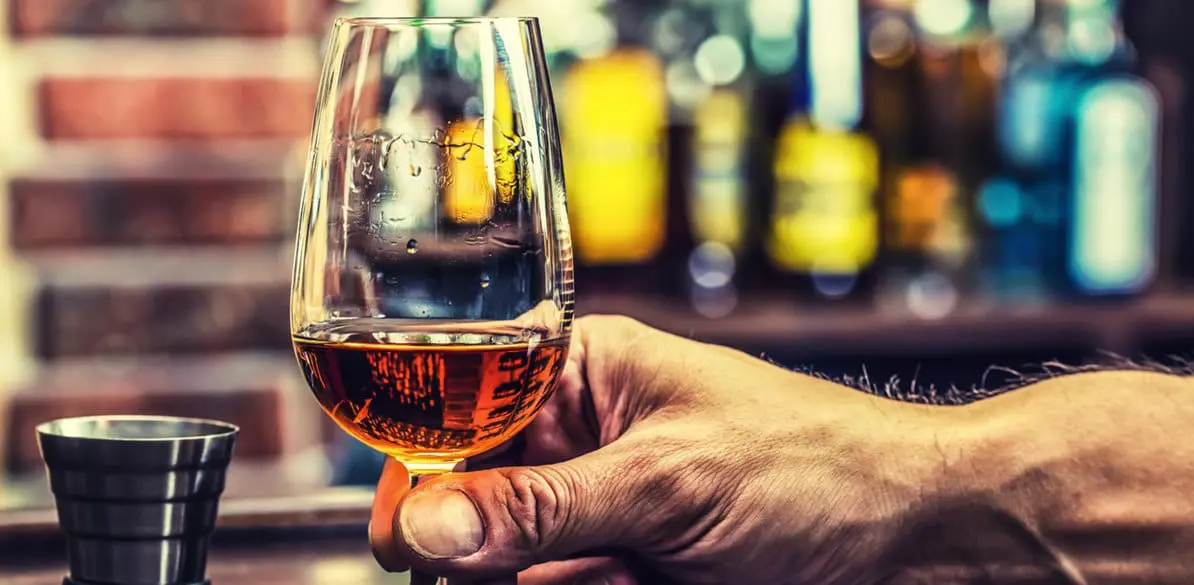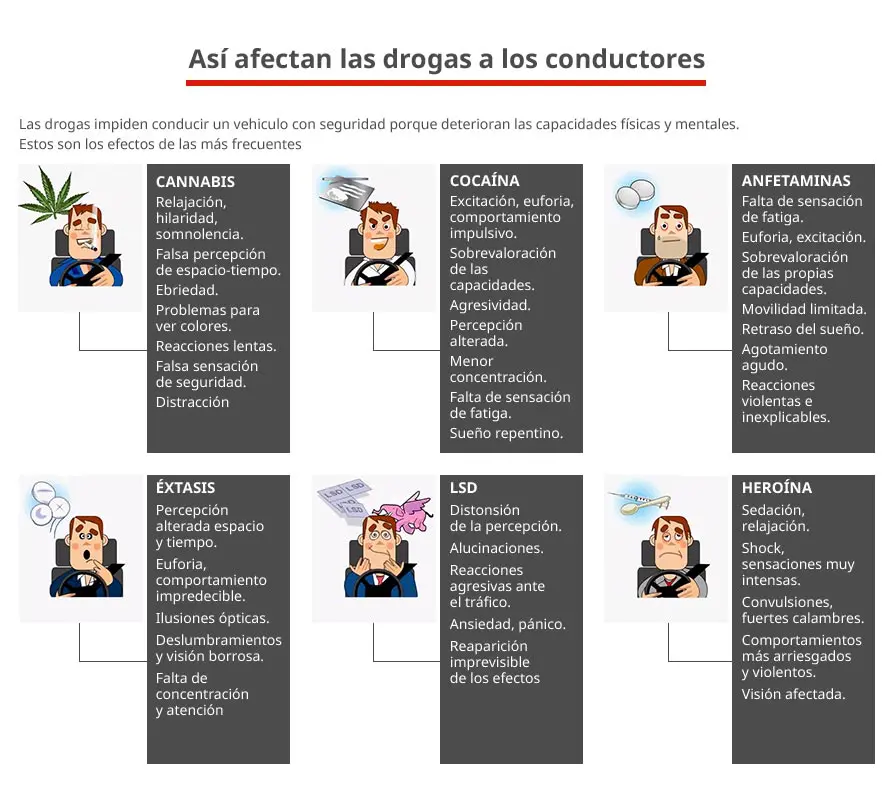Drugs and driving – zero tolerance

Written by Dr Juan Carlos Recio Velasco
GP at the Andrés Mellado Health Center in Madrid
Drugs, recreation and driving is a potentially lethal combination. Around 23% of drivers under the age of 30 who die in road accidents have taken drugs.
In the last few years, numerous campaigns have been rolled out against the use of alcohol and driving, either trying to raise people’s awareness or with the threat of punishment by means of fines and loss of points from drivers’ licenses. However, drugs are just as dangerous as alcohol and their use is becoming more and more widespread.
According to the DRUID’13 Study and the 2013 Report by the National Institute of Toxicology and Forensic Sciences, of drivers between the ages of 18 and 24, 15% tested positive for cannabis and almost 4% for cocaine. We need to remember that the effects on the body remain for up to three to four hours after their consumption. It is also worth mentioning the fact that of those who tested positive, 93% were men and only 7% were women.
In 2013, the National Toxicology Institute analyzed the blood samples of 557 drivers who had died in road accidents; of these, 43% showed positive for drugs, alcohol, psychotropic drugs or a mixture of them all. Although there has been a slight drop in the consumption of alcohol, falling from 35% to 28% since 2012, we have seen an increase in the consumption of drugs, rising from 12% to 15%, and from 13% to 14% in the case of psychotropic drugs.
In addition, the Official State Gazette of 8 April 2014 regulated administrative penalties for the mere presence of drugs in a driver’s body, making driving under the influence of drugs a criminal offense and upholding the use of devices for detecting drugs in saliva, which have proven to be a legally reliable, non-intrusive method which is viable from the police force’s perspective.
When talking about drugs that have an effect on driving, we are essentially referring to the following groups: opiates, cocaine, cannabis and designer drugs. Each one acts in a different way, and below we describe the effects they have on our bodies and how they affect drivers.
- Opiates: The natural opiates are morphine and heroin, and synthetic ones include methadone and oxycodone. They can be taken in the form of either prescription or recreational drugs. They can be smoked, inhaled or injected. There is a definite decline in the use of these drugs, yet 0.3% of samples taken from accident victims tested positive. We should not forget that medicines for coughs, such as cough mixtures containing codeine, or for pain, such as the combination of codeine with other analgesics, can also affect driving. Opiates act on the Central Nervous System, slowing down all the body’s functions and causing drowsiness and torpor. They inhibit people’s reaction time to sounds and visual stimuli, reduce the speed of decision-making and slow down coordination of movements.
An individual under the effects of opiates is not fully conscious of his or her actions; they might do things, but have little awareness of their actions and no sense of responsibility or appreciation of the consequences. They exhibit a total lack of self-criticism and are unable to clearly appreciate risks and dangers. It goes without saying that their mental state clearly precludes driving, but also from a purely mechanical point of view their coordination is poor, they experience difficulties in operating the pedals and steering wheel, and they tend to make mistakes when calculating distances and making the right decisions. - Cocaine: ocaine can be inhaled, sniffed or injected. Its use is more common, traces having been found in 4% of road accident fatalities. It is difficult to detect cocaine in users as at first glance it does not have a detrimental effect on people’s appearance or show any immediate physical deterioration, but actually makes people livelier. Some people take it regularly to maximize their performance or to ‘keep going’ thanks to its stimulating effect, helping to make them ‘look good’. This combination of circumstances leads users to fall into routine ‘normal’ use which conceals their addiction under a false sense of being in control of the situation. On top of this, certain people in public life admit to taking cocaine which gives it a certain glamor that other drugs don’t have. It acts on the Central Nervous System, causing euphoria, hyperactivity, a feeling of power and strength, a diminished sense of fatigue, insomnia and loss of self-criticism.
From a mechanical point of view, people tend to use controls too hurriedly, make mistakes in calculating distances, become impatient and suffer from attention deficit. When driving, this can lead to recklessness. An attitude of “I can do anything” and the Superman syndrome are extremely dangerous in driving because they prevent drivers from properly assessing risks and push them into dangerous situations as a consequence of ‘show-off’ actions. A practical example are those people who believe they are the kings of the road, blithely ignoring traffic regulations, road signs and speed limits. They drive like maniacs, intimidating other drivers, driving at high speeds and overtaking recklessly without any awareness whatsoever of risk. This is the typical ‘suicide’ driver who drives on the wrong side of the road. - Cannabis: Cannabis can be either inhaled or taken orally. Its use is very common among young people and traces have been found in 15% of road accident fatalities aged between 18 and 24. It is a social drug which is often taken with friends and at first sight does not seem to entail any danger, so there are many initiatives underway to legalize it. The most recent Eurobarometer on the relationship between youth and drugs showed that 45% of young people aged between 15 and 24 are in favor of legalizing cannabis, in contrast to the figure of over 90% who are against the legalization of cocaine or ecstasy. This is the typical digression between ‘soft’ and ‘dangerous’ drugs, but all of them affect the body and pose a hazard to driving. Various US states have authorized the sale of cannabis for the treatment of chronic pain. It acts on the Central Nervous System, slowing down all bodily functions and reaching its peak about one hour after ingestion (i.e. after having smoked a joint), but its effects remain in the body for 4-5 hours afterwards.
It causes impairments to the perception of time and space, reducing people’s ability to make judgments and choose the right action at any given time. On a mechanical level, it slows down the reflexes, meaning that all motor actions are done more slowly, and it also causes drowsiness and conjunctival irritation with a decline in visual capacity accompanied by changes in color perception. In some cases it can lead to states of paranoia, anxiety, euphoria or lack of inhibition.
Driving under the effects of cannabis means people perform more slowly in terms of both speed and reaction time in the case of any unexpected incident, as well as causing impaired vision which is one of the most important senses when driving. Also, it is often associated with drinking alcohol, even further increasing the risks at the wheel. - Designer drugs: This group includes amphetamines, ecstasy, various synthetic drugs, ketamine, etc. These drugs can even be concealed in drinks so the person is completely unaware that they have taken them. They are very much associated with parties and their consumption considerably increases in the summer months, given that this is vacation time which releases people from routine and responsibilities and makes these kinds of drugs more accessible. Up until now some 0.5% of accident fatalities have shown positive for these drugs, but their consumption is increasing steadily. Any drug, in itself, is a problem, but synthetic drugs have an added complication and that is that in most cases the users have no idea what the compound is made of and how it interacts with the body, and do not really even know what they are taking or how it will affect them. Furthermore, various celebrities have admitted to taking ecstasy which associates its consumption with an image of success. The action of these substances on the Central Nervous System puts people in a state of hyper-alertness, excitement, delayed sleep, lack of concentration, blurred vision and violent reactions. On a mechanical level, they can cause coordination problems with the loss of the ability to visualize what actions need to be taken.
When it comes to driving, people who have taken designer drugs have difficulties in concentrating or staying in the right position. Their sense of excitement and agitation means they constantly play with the different controls without any clear objective. When driving they behave very recklessly and are easily distracted; they have no perception of danger and are in such a state of euphoria that it incites them to take more risks than usual, as well as being prone to violent outbursts which makes them especially dangerous in stressful situations such as heavy traffic, traffic jams, waiting at traffic lights, etc.
We should not forget that apart from all these illegal drugs, a huge amount of prescription drugs are taken in Spain which can also affect driving, such as benzodiazepines and hypnotics, a subject on which we will be devoting an article in May. We need to emphasize the precautions that people should take when driving whenever these drugs are prescribed. Psycho-pharmaceuticals have been found in 4% of road accident fatalities. These drugs are more commonly taken by middle aged and elderly people than by youngsters, who are more likely to show positive for recreational drugs.

To see this animated infograph, click here. Source: DGT
Finally, it should be remembered that the leading cause of death in people aged 15 to 24 in Spain is traffic accidents, and that the consumption of drugs and alcohol plays a big part in these accidents.
Despite the drop in the number of deaths from road accidents in recent years, it is still a major public health problem. It is the primary cause of death among young people aged 15 to 24 and we should not forget that of the drivers who died in 2013 whose blood was analyzed by the Toxicology Institute, 43% showed positive for drugs, alcohol or prescription medicines.
In view of this problem we need to achieve a goal of zero consumption at any age, with the following advice:
- Driving under the effects of ANY drug entails a serious risk of accident; if you take them, don’t drive.
- Plan your day or evening out and use other means of transport; a great many accidents happen on leaving parties.
- Drugs cause a false sense of being in control, but one thing is your perception and another is the actual reality.
- Waiting a while for the effects to diminish is not a solution – many substances continue to act up to five hours after they have been taken and they remain in the blood for 3-6 hours.
- There is no such thing as risk-free consumption, either for you or for other people.
Bibliography:
- DGT Journal of 5 May 2014.
- Traffic and road safety no. 212/2012.
- Traffic and road safety no. 221/2013.
- A case-control study estimating accident risk for alcohol, medicines and illegal drugs. Plos August 2012.
- First aid for drug addicts. Community of Madrid. Anti-Drug Agency 2012.
- First Aid Action Guidelines. SEMFYC. 513-521.
- Illegal drugs and driving. Medicina Clinica. Vol 135. October 2010.
